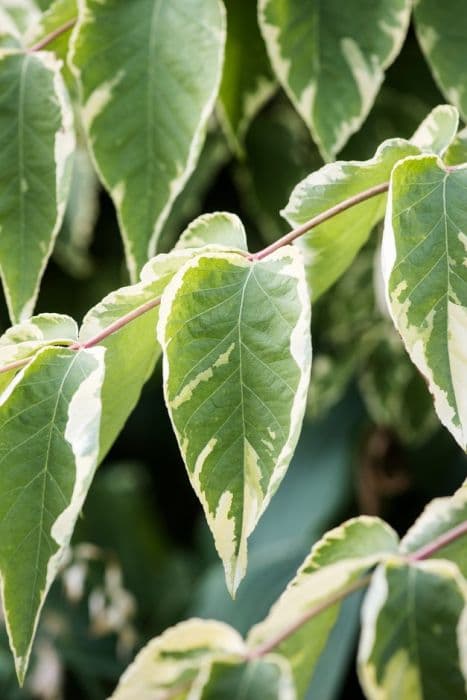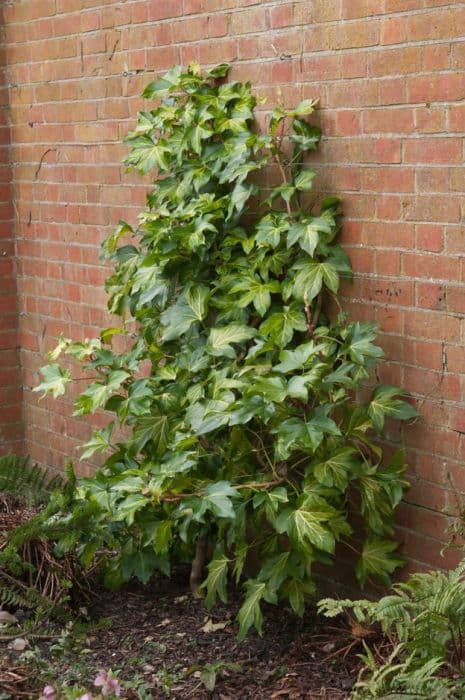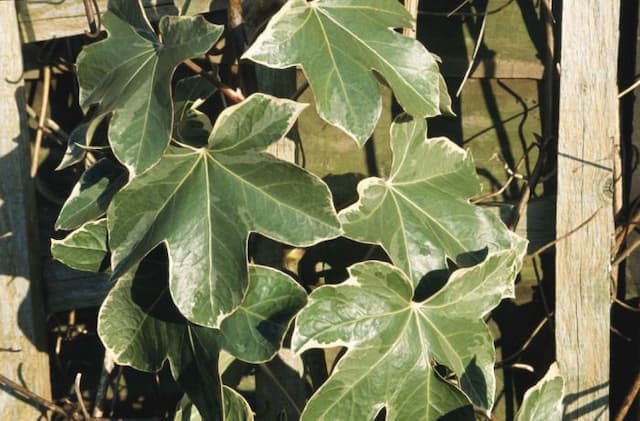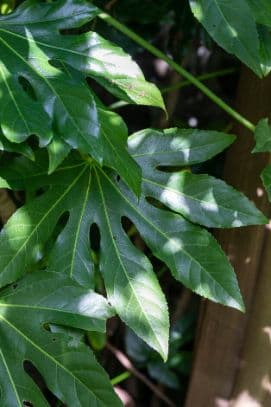Irish Ivy Hedera hibernica

ABOUT
Commonly known as Irish ivy, Hedera hibernica is a lush, evergreen climbing vine that is recognized for its dense foliage. The leaves are rich green and glossy, with a pronounced, heart-shaped base that tapers to a point. The leaves are arranged alternately on the stems, which enhance their aesthetic appeal. Each leaf is typically made up of three to five lobes, with the central lobe being the longest. The surface of the leaves is smooth with conspicuous veins running through them, providing a texture that is both visually and tactilely pleasing. The edges of the leaves are slightly wavy, which adds to the plant's decorative character. In terms of its climbing ability, Irish ivy has specialized root-like structures called aerial roots that allow it to adhere to surfaces. This enables it to spread across walls, fences, and other supports with relative ease, and also contributes to its use as an ornamental plant for covering unsightly areas. Throughout the year, its appearance remains mostly unchanged, with the exception of small clusters of flowers that may appear. These are typically yellow-green in color and insignificant in comparison to the foliage. Following the flowers, small black or dark blue berries may develop, which can attract birds and other wildlife. Overall, the appearance of Irish ivy is one of lushness and vitality, making it a popular choice for adding evergreen coverage and a touch of nature to both urban and rural landscapes.
About this plant
 Names
NamesSynonyms
Atlantic Ivy, Irish Ivy
Common names
Hedera helix ssp. hibernica, Hedera helix var. hibernica.
 Toxicity
ToxicityTo humans
The plant commonly known as Irish ivy (Hedera hibernica) is considered toxic to humans if ingested. The plant contains saponins and polyacetylene compounds, which can cause gastrointestinal symptoms such as vomiting, diarrhea, and abdominal pain. In addition, contact with the sap may lead to skin irritation or allergic reactions in some individuals. If large quantities of the plant are consumed, it could potentially result in more severe symptoms, thus care should be taken to prevent ingestion, especially among children and pets.
To pets
Irish ivy (Hedera hibernica) is also toxic to pets. If ingested by pets such as dogs or cats, it can cause similar symptoms to humans, including vomiting, abdominal pain, hypersalivation, and diarrhea. The consumption of even small amounts may lead to these gastrointestinal disturbances. In some cases, the ingestion of large quantities might result in more serious conditions such as coma or rarely, death. Therefore, it is crucial to prevent pets from having access to this plant. If you suspect your pet has ingested Irish ivy, it is important to consult a veterinarian immediately.
 Characteristics
CharacteristicsLife cycle
Perennials
Foliage type
Evergreen
Color of leaves
Green
Height
50 feet (15 meters)
Spread
10 feet (3 meters)
Plant type
Climber
Hardiness zones
5
Native area
Europe
Benefits
 General Benefits
General Benefits- Aesthetic Appeal: Adds lush greenery and can enhance the visual interest of both indoor and outdoor spaces.
- Coverage: Ideal for covering walls, fences, and trellises, and can be used to create a green facade.
- Erosion Control: Its root system can help prevent soil erosion on slopes and banks.
- Habitat for Wildlife: Provides shelter and nesting sites for birds and beneficial insects.
- Privacy Screen: When grown densely, it can act as a privacy screen and noise buffer.
- Climbing and Trailing: Versatile growth habit allows it to either climb structures or trail along the ground or in hanging baskets.
- Low Maintenance: Once established, it requires minimal care and is tolerant of a wide range of conditions.
- Seasonal Interest: Some varieties offer year-round foliage while others provide seasonal changes in leaf color.
- Shade Tolerance: Thrives in shady areas where other plants might struggle to grow.
- Durability: Resistant to deer and other grazing animals, as well as being relatively pest-free.
 Medical Properties
Medical Properties- This plant is not used for medical purposes
 Air-purifying Qualities
Air-purifying QualitiesThis plant is not specifically known for air purifying qualities.
 Other Uses
Other Uses- Hedera hibernica, commonly known as Irish ivy, can be used as a natural dye for fabrics, providing a range of green hues depending on the mordant used.
- Ivy League universities were named for the habit of planting Irish ivy on the buildings, which symbolizes academic achievement and tradition.
- In garden landscapes, Irish ivy is often used to create living sculptures by training it over frameworks to form topiaries, providing year-round green structures.
- Irish ivy leaves can be used in floral arrangements to add green, lush backdrops or to provide cover in potted plant compositions.
- Due to its ability to adhere to surfaces, Irish ivy can be used as a natural fencing material, forming a dense barrier when grown against wire or wooden fences.
- The dense canopy of Irish ivy can be utilized to offer nesting sites and protection for birds like robins and thrushes in gardens and wildlife areas.
- Ivy planted on steep slopes can act as erosion control by stabilizing the soil with its root system and preventing runoff.
- When intertwined with other plants on arbors or pergolas, Irish ivy creates shaded, cool areas for relaxation and aesthetic appeal in landscapes.
- In crafts, the flexible stems of Irish ivy can be woven into wreaths and other decorative items for a touch of natural beauty.
- The dense and luxuriant growth habit of Irish ivy makes it suitable for creating privacy screens on patios or balconies when grown in containers or on trellises.
Interesting Facts
 Feng Shui
Feng ShuiThe Irish ivy, commonly known as Hedera hibernica, is not used in Feng Shui practice.
 Zodiac Sign Compitability
Zodiac Sign CompitabilityThe Irish ivy is not used in astrology practice.
 Plant Symbolism
Plant Symbolism- Friendship: Hedera Hibernica, also known as Irish Ivy, has been traditionally associated with friendship due to its tendency to interweave and bond firmly with structures and other plants, symbolizing the intertwining of lives.
- Fidelity: Irish Ivy is often used to represent fidelity and loyalty in relationships, as it clings and stays green throughout the year, reflecting the idea of sticking with a partner through all seasons of life.
- Protection: The plant was believed to ward off evil spirits in ancient times, making it a symbol of protection and safekeeping.
- Eternal Life: Due to its evergreen nature, Irish Ivy is sometimes seen as a symbol of immortality and eternal life, as it remains vibrant even in the harshest of winters.
- Wedding Symbolism: Its association with fidelity and lasting bonds makes Irish Ivy a popular choice in wedding bouquets or decorations, to symbolize the hope for a lasting and loving marriage.
 Water
WaterThe Atlantic Ivy should be watered thoroughly when the top inch of soil feels dry to the touch, which is generally every 7 to 10 days, depending on the environment. The method of watering should be to slowly pour water at the base of the plant until it begins to drain out of the bottom of the pot, ensuring that the soil is moist but not waterlogged. In cooler months, when the plant is not actively growing, reduce watering frequency. Typically, around half a gallon of water should suffice for a standard indoor pot in each session. Always check the soil moisture level before watering to avoid overwatering, which could lead to root rot.
 Light
LightThe Atlantic Ivy thrives in bright, indirect light but can also adapt to low-light conditions. It is best to place the plant near a north or east-facing window where it can receive plenty of light without being exposed to the harsh afternoon sun. Avoid direct sunlight, as it can scorch the leaves of the plant. If you notice the leaves becoming pale, it may indicate that the plant is receiving too much light.
 Temperature
TemperatureThe Atlantic Ivy prefers a temperature range between 50°F and 70°F for optimal growth and can survive in temperatures as low as 30°F and as high as 90°F. Keep it away from drafts, heating and cooling vents, and other sources of extreme temperature changes. The best indoor spot is one where the temperature remains consistent and within the preferred range.
 Pruning
PruningPrune the Atlantic Ivy to maintain its shape, control its size, and encourage fuller growth. The best time to prune is in the spring or early summer, just before new growth begins. It's beneficial to prune the plant regularly, about once a year, by cutting back overgrown or unwanted vines. Pruning also helps prevent the spread of pests and diseases by allowing better air circulation within the foliage.
 Cleaning
CleaningAs needed
 Soil
SoilIrish Ivy thrives in well-draining soil with a mix of two parts peat moss, one part perlite, and one part garden soil, maintaining a soil pH of 6.0 to 7.5 for optimal growth.
 Repotting
RepottingIrish Ivy should be repotted every two to three years to refresh the soil and accommodate its growth, less frequently as the plant matures.
 Humidity & Misting
Humidity & MistingIrish Ivy prefers high humidity but is tolerant of a wide range, aiming for 40-60% for robust health.
 Suitable locations
Suitable locationsIndoor
Place Irish Ivy in bright, indirect light with some direct morning sun.
Outdoor
Plant Irish Ivy in part shade to full shade, ensuring it's moist and well-drained.
Hardiness zone
5-11 USDA
 Life cycle
Life cycleThe Atlantic Ivy, or Hedera hibernica, begins its life cycle when seeds disperse from the mature berries, often with the aid of birds. Germination occurs in moist, shaded soil conditions, where the seed establishes a root system and sprouts juvenile leaves, which are typically lobed. As a vigorous evergreen climber, it enters a long vegetative stage, where it attaches to surfaces with root-like structures called adventitious roots and spreads horizontally and vertically. When it reaches maturity after several years, it produces adult, unlobed leaves on flowering stems that no longer climb but extend outward and upward. Pollination of its small, green-yellow flowers typically involves insects, leading to the development of its berry-like fruits. After pollination and fruit maturation, the cycle restarts when the fruits are consumed and dispersed, or when stem fragments take root to form new plants, a form of vegetative reproduction.
 Propogation
PropogationPropogation time
Spring-Early Summer
The most popular method to propagate Hedera hibernica, commonly known as Irish Ivy or Atlantic Ivy, is through stem cuttings. This method is typically done in late winter or early spring before the plant begins its active growth phase. To propagate by cuttings, a gardener would take a stem cutting of around 4-6 inches (10-15 cm) long, ensuring it has several leaves. They would remove the leaves from the bottom half of the cutting and dip the cut end into rooting hormone to encourage root development. The stem cutting is then planted in a pot with moist soil, pressing it gently to make the soil firm around the stem. The pot should then be placed in indirect sunlight and kept consistently moist. Roots usually form in a few weeks, after which the new Ivy plant can be transplanted if needed.









